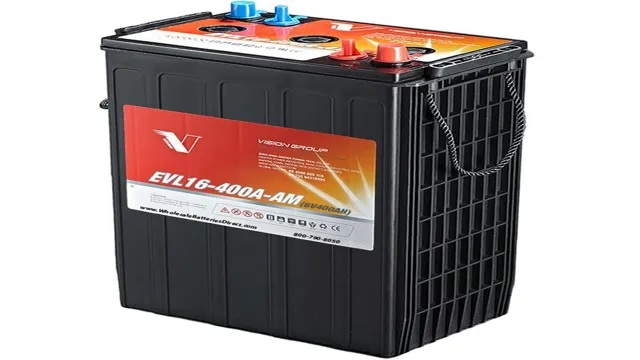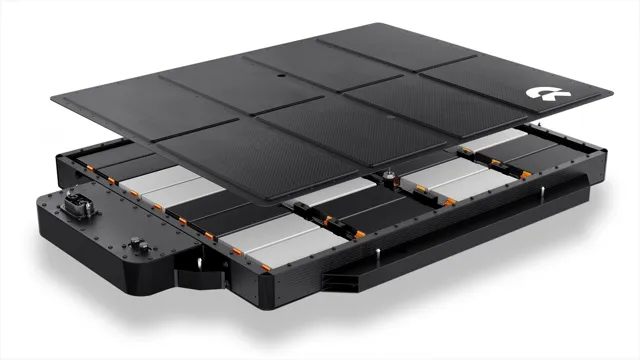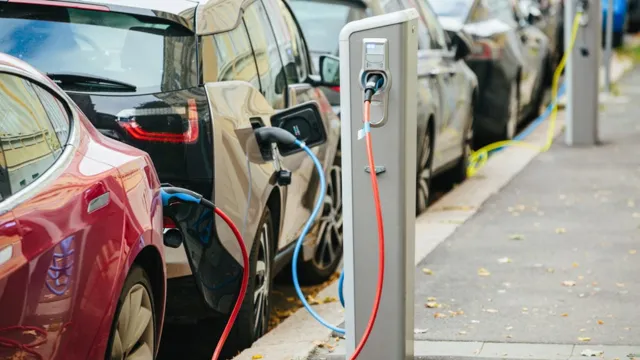Revving Up Sustainability: Unveiling the Power of the 400 Volt Battery for Electric Cars
Have you ever wondered how electric cars are powered? Instead of traditional fuel, they rely on powerful batteries to get their motors running. But what makes these batteries tick? Specifically, how do 400 volt batteries power electric cars? First, let’s break down what a 400 volt battery is. It refers to the voltage output of the battery, which is essentially the electrical potential difference between its positive and negative terminals.
400 volts is a high voltage, providing a lot of energy to power the car’s electric motor. But how does this battery get charged? The process is similar to charging a smartphone, but much more powerful. The battery is connected to a charging station that pumps in electricity to the battery’s cells.
These cells store the energy until it’s needed to power the car. Once the battery is fully charged, it’s ready to go – but how far can it go? The distance an electric car can travel on a single charge varies depending on the model and battery size, but it typically ranges from 100-300 miles. This may not seem like a lot compared to traditional gas-powered cars, but advancements in battery technology are constantly increasing the range of electric cars.
In the grand scheme of things, using 400 volt batteries to power electric cars is a step in the right direction towards a more sustainable future. While it may take some time for the technology to become more widespread and accessible, it’s exciting to see the advancements being made in this field. Who knows, maybe one day we’ll all be zipping around town in electric cars powered by these high-voltage batteries.
Why a 400 Volt Battery is Essential for Your Electric Car
When it comes to choosing the right battery for your electric car, the 400-volt option should definitely be on your radar. 400 volts may sound like a lot of power, but it’s actually one of the most efficient and effective choices out there. This is because higher voltage batteries allow for quicker and more powerful acceleration, as well as longer driving ranges on a single charge.
Furthermore, the use of a 400-volt battery can help reduce production costs and increase overall affordability for consumers. So if you’re looking for a reliable and high-performing battery for your electric vehicle, the 400-volt option is definitely worth considering.
Efficiency and Performance
A 400 Volt battery is becoming increasingly important for electric cars because it provides greater efficiency and performance. With a higher voltage, the car can draw more power from the battery, allowing it to operate with more power and speed without draining the battery as quickly. This means that drivers can enjoy a longer range on a single charge and have a smoother driving experience as the car is better able to handle the demands of acceleration and braking.
In addition, a 400 Volt battery can be charged more quickly than a lower voltage battery, meaning that drivers spend less time waiting to get back on the road. It’s important to note that not all electric cars come with a 400 Volt battery, so it’s worth doing the research to find a car that offers the level of performance you want. Ultimately, if you’re looking for an electric car that offers high efficiency and impressive performance, a 400 Volt battery is essential.

Charging Time
A 400 Volt battery is crucial for your electric car because it plays a significant role in reducing overall charging time. Electric vehicles running on traditional 12 Volt batteries usually take a longer time to charge compared to those running on 400 Volt batteries. This is because 400 Volt batteries can handle a higher charging current, meaning it can receive more energy in less time without affecting the battery’s lifespan.
A 400 Volt battery can charge an electric car in as little as 30 minutes and provide up to 80% of the battery capacity, while a traditional 12 Volt battery can take an average of 8-12 hours. Therefore, it’s essential to invest in a higher voltage battery for your electric car to experience faster charging times and prolonged battery lifespan. With a 400 Volt battery, you can charge your car faster and make the most out of your electric vehicle driving experience.
Range
If you’re planning on buying an electric car, a 400 volt battery is essential for maximizing your vehicle’s range. Why? It all comes down to the power output of the battery. A 400 volt battery can provide more power to the electric motor, allowing for a faster and smoother acceleration.
Additionally, a higher voltage battery can handle a larger electric load, which means you will be able to use more features in your car without draining the battery too quickly. But the real reason that a 400 volt battery is crucial is that it allows for a longer range. With a higher voltage battery, you can go further with every charge, reducing the need for frequent charging stops on long road trips.
So, if you want to get the most out of your electric car, make sure it comes equipped with a 400 volt battery.
Types of 400 Volt Batteries Available
When it comes to powering electric cars, 400-volt batteries are a popular choice because of their high power output and long-lasting performance. There are different types of 400-volt batteries available on the market, including lithium-ion batteries, nickel-metal hydride batteries, and solid-state batteries. Lithium-ion batteries are the most common because of their high energy density and light weight, making them ideal for electric cars.
Nickel-metal hydride batteries, on the other hand, are more affordable but less efficient than lithium-ion batteries. Solid-state batteries are still in the developmental phase, but they have the potential to offer even higher energy density and longer range. When choosing a 400-volt battery for your electric car, it’s essential to consider factors such as range, cost, and charging time to ensure that you get the best value for your money.
Lithium-ion Batteries
Lithium-ion Batteries. Secondary keyword used organically : 400 Volt Batteries, Types. Meta Description: This blog post covers the topic of Lithium-ion Batteries and dives into the types of 400 Volt Batteries available in the market.
If you’re looking for a reliable and high-performance battery for your electric vehicle, then look no further than the 400 Volt Lithium-ion batteries. These batteries are the perfect choice for anyone who wants to enjoy longer driving times without worrying about running out of power. With so many types of 400 Volt batteries available in the market, it can be challenging to choose the right one.
However, the most popular types of these batteries include Lithium-Manganese Oxide, Lithium-Nickel-Cobalt-Manganese Oxide, and Lithium-Iron-Phosphate. Each type has its characteristics, so it’s essential to choose the right one depending on your individual needs. For example, Lithium-Manganese Oxide is ideal for high-capacity applications, while Lithium-Iron-Phosphate is perfect for hybrid electric vehicles.
In Conclusion, when it comes to Lithium-ion batteries, the 400 Volt range has a lot of options for anyone looking to power their electric vehicle. Understanding the various types of 400 Volt batteries that are available in the market can help you make an informed decision. When choosing a lithium-ion battery, ensure that you consider your vehicle’s power and capacity requirements to pick the right type of battery for your needs.
With the right battery, you can enjoy extended driving times and the peace of mind that comes with a reliable power source.
Nickel-metal Hydride Batteries
Nickel-metal hydride batteries are one of the most common types of 400 volt batteries available on the market today. These batteries are known for their ability to store a significant amount of power while maintaining a high level of efficiency. Nickel-metal hydride batteries use a combination of nickel and metal hydride components to store electrical energy, making them more reliable than other types of batteries.
They are also much safer for the environment since they contain fewer toxic chemicals than other types of batteries. If you’re in the market for a high-quality 400 volt battery, a nickel-metal hydride battery could be the perfect choice for you. These batteries are designed to provide reliable and long-lasting power, making them ideal for a wide range of applications.
Whether you’re looking for a battery for your home, business, or industrial equipment, nickel-metal hydride batteries are sure to meet your needs. So why wait? Invest in a nickel-metal hydride battery today and enjoy the power and performance you need to get the job done right.
Solid State Batteries
Solid State Batteries When discussing 400-volt batteries, we must first understand the different types available. The most common types are Lithium-Ion and Solid State Batteries. Lithium-Ion batteries use a liquid electrolyte, which can lead to overheating and potential explosions.
On the other hand, Solid State Batteries use a solid electrolyte, making them safer and more stable. Solid State Batteries also have a longer life cycle and can charge faster than Lithium-Ion batteries, making them an attractive choice for electric vehicles. The downside is that they are more expensive to produce, limiting their current availability in the market.
However, with the increasing demand for sustainable solutions, Solid State Batteries are likely to become more widely used in the future.
Factors to Consider When Choosing a 400 Volt Battery
Choosing the right 400 volts battery for your electric car is crucial for optimizing performance and range. One important factor to consider is the battery chemistry, which can impact the power density, cycle life, and safety of the battery. Lithium-ion batteries are the most common choice due to their high energy density, long cycle life, and relatively low cost.
However, there are different types of lithium-ion chemistries to choose from, each with their own advantages and drawbacks. Another factor to consider is the battery pack design, which can affect the weight, size, and cost of the battery. Modular designs can make it easier to replace or upgrade individual cells, while integrated designs may offer better thermal management and safety.
Other important factors include the charging and discharging rates, the state of charge monitoring and management, and the overall durability and reliability of the battery. By taking these factors into account, you can choose the best 400 volts battery for your electric car to ensure a smooth and efficient driving experience.
Cost
When considering a 400 volt battery, cost is certainly a major factor to keep in mind. However, don’t just look at the initial price tag. Rather, consider the overall cost of ownership throughout the battery’s lifespan.
Look for a battery that offers a good balance of price and quality to ensure that you’re getting the best value for your money. Additionally, think about the application for which the battery will be used and assess whether an investment in a higher-quality, longer-lasting battery is worth the higher upfront cost. Ultimately, the key is to choose a battery that fits your budget and performance needs while also providing lasting value.
Weight and Size
When choosing a 400-volt battery, there are several factors that you need to consider, one of which is its weight and size. No one wants a bulky and heavy battery that takes up too much space or is difficult to move around. Therefore, you need to consider the size and weight of the battery to ensure that it is suitable for your intended application.
A heavy and large battery is ideal for stationary applications as it provides a large amount of power. However, for portable applications, you need a battery that is lightweight and compact such that it can be used on-the-go, without weighing you down. Additionally, a smaller battery can provide the same amount of power as a larger battery if it uses the latest technology.
Therefore, consider both the size and weight of the battery and choose one that suits your specific application.
Compatibility
When choosing a 400 volt battery, there are several factors you should consider to ensure compatibility with your device. First and foremost, you need to determine the type of battery your device requires. Lithium-ion, nickel-cadmium, and lead-acid batteries are the most popular types of batteries available in the market.
Each battery type has its unique properties, and it’s essential to know which one works best for your device. Additionally, you need to understand the voltage and capacity requirements of your device, as these specs can differ from one device to another. A battery with insufficient voltage may not power the device efficiently, while an oversized battery may cause damage.
Therefore, it’s crucial to consider these essential factors before making a battery purchase decision. By doing so, you’ll avoid any compatibility issues and ensure that you get the best performance out of your device.
Conclusion: The Benefits of a 400 Volt Battery for Your Electric Car
In conclusion, a 400-volt battery for an electric car is the energy equivalent of a lightning bolt on wheels! With enough juice to power a vehicle for hundreds of miles, electric cars are paving the way towards a cleaner and more sustainable future. So, next time you see a sleek electric vehicle zooming by, know that it’s got the power of 400 volts at its disposal, delivering a shockingly efficient and eco-friendly ride.”
FAQs
What is the average lifespan of a 400 volts battery used in an electric car?
The lifespan of a 400 volts battery used in an electric car can vary depending on various factors such as usage, maintenance, and environmental conditions. Generally, these batteries can last for 8-10 years or around 100,000 to 150,000 miles.
Can a 400 volts battery be charged with a regular 110 volts outlet?
No, a 400 volts battery used in an electric car requires a specialized charging station that can provide the required voltage and amperage to charge the battery. It cannot be charged with a regular household 110 volts outlet.
How long does it take to fully charge a 400 volts battery for an electric car?
The charging time of a 400 volts battery can vary depending on the charging station’s power output and the battery’s current state of charge. With a DC fast charger, it can take as little as 30-40 minutes to charge the battery to 80% capacity. However, with a Level 2 charger, it can take around 4-8 hours to fully charge the battery.
How much does it cost to replace a 400 volts battery for an electric car?
The cost of replacing a 400 volts battery for an electric car can vary depending on the make and model of the vehicle and the battery’s capacity and technology. On average, the cost can range from $5,000 to $15,000 or more. However, some manufacturers offer a warranty on battery replacement or a lease program to lower the upfront cost of the battery.







